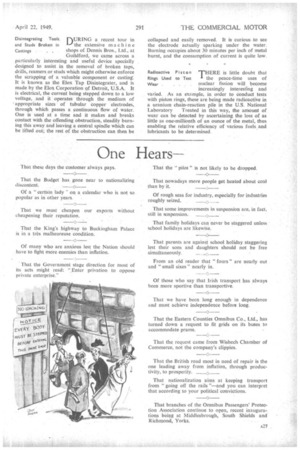Passing Comments
Page 2

Page 3

If you've noticed an error in this article please click here to report it so we can fix it.
Telephone Service to 'ROTH America and Canada Road Vehicles Making ." are making considerable Headway . . . . use of the special telephone
service to motor vehicles. Equipment permitting drivers to make and receive calls while travelling has been established in over 60 cities there, and transmitting staRons assist the service to „those on highways outside them. The first urban service was inaugurated in 'St. Louis, Missouri, in June, 1946, and a highway service in Wisconsin two months later. Urban systems served some 4,000 vehicles in their first two years, handling about 117.000 call§ monthly, whilst the highway stations dealt with 1,900 vehicles and 36,000 calls a month. To avoid interference., America is divided into seven zones, each with its own frequency, the driver switching over as he moves from one zone to another.
A26
How Light Alloys THE use of light alloys for Save Many Body1 bodybuilding has other building Problems. . attractions than that of increasing payload. When used for bodies going overseas it possesses the valuable attribute of being proof against insect pests, a serious problem where untreated wood bodies are concerned. Then again, if left unpainted, as is done with refrigerator bodies, the interior remains -much cooler than where the usual finishes are applied. Such bodies, too, can be virtually sealed at the joints, which prevents any possibility of destruction coming from the inside. The use of light alloYs for body construction is not a passing phase; it will remain even when the best woods are once more readily available. Pop-riveting has proved a rapid and secure method of fabrication. Such bodies can be built by semi-skilled labour. Disintegrating Tools, URING a recent tour in and Studs Broken in 1-'" the extensive machine Castings . shops of Dennis Bros., Ltd., at Guildford, we came across a particularly interesting and useful device specially designed to assist in the removal of broken taps, drills, reamers or studs which might otherwise enforce the scrapping of a valuable component or casting: It is known as the Elox Tap Disintegrater, and is made by the Elox Corporation inf Detroit, U.S.A. It is electrical, the current being stepped down to a low voltage, and it operates through the medium of appropriate sizes of tubular copper 'electrodes, through which passes a continuous flow of water. One is used at a time and it makes and breaks contact with the offending obstruction, steadily burning this away and leaving a central spindle which can be lifted out; the rest of the obstruction can then be collapsed and easily removed. It is curious to see the electrode actually sparking under the water. Burning occupies about 30 minutes per inch of metal burnt, and the consumption of current is quite low.
Radioactive Piston THERE is little doubt that Rings Used to Test I the peace-time uses of Wear . nuclear fission will become increasingly interesting and varied. As an example, in order to conduct tests with piston rings, these are being made radioactive in a uranium chain-reaction pile in the U.S. National Laboratory Treated in this way, the amount of wear can be detected by ascertaining the loss of as little as one-millionth of an ounce of the metal, thus enabling the relative efficiency of various fuels. and lubricants to be determined.


























